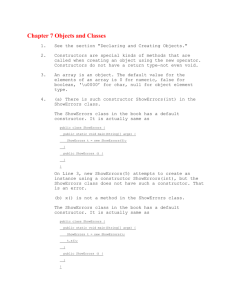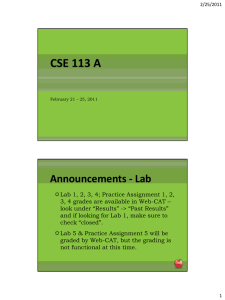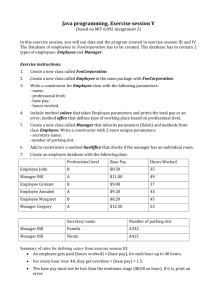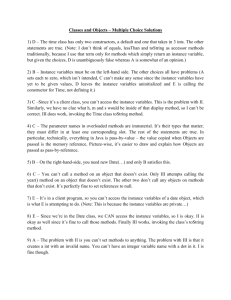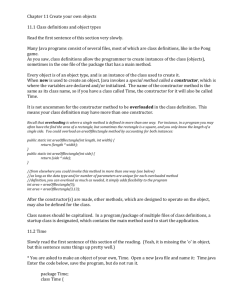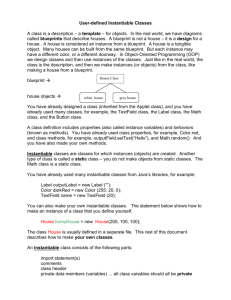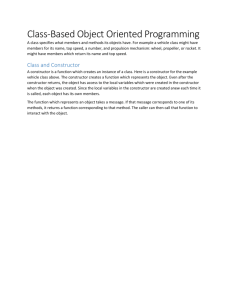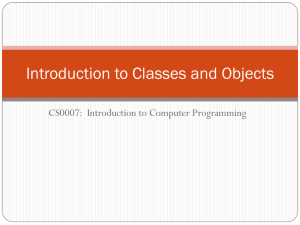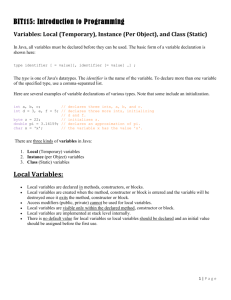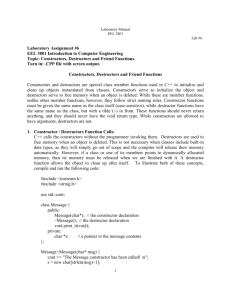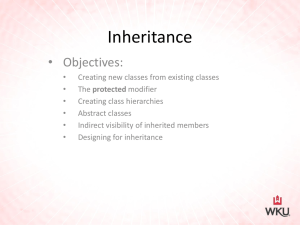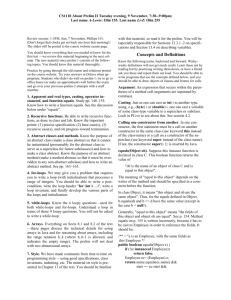Chapter 8 Objects and Classes
advertisement
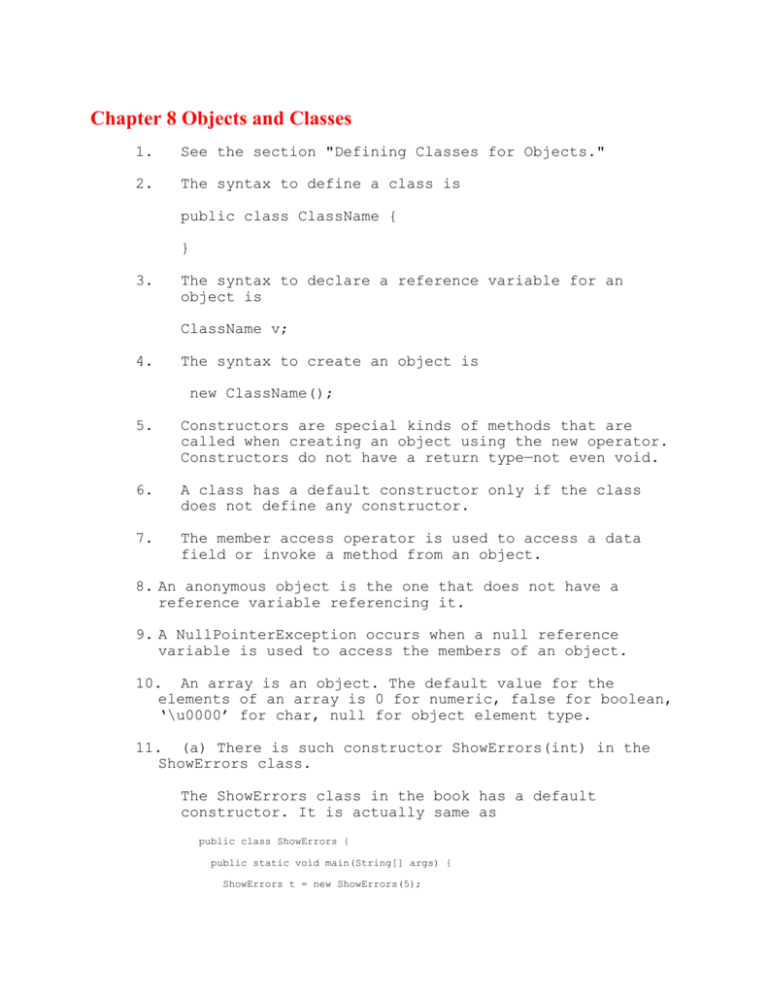
Chapter 8 Objects and Classes
1.
See the section "Defining Classes for Objects."
2.
The syntax to define a class is
public class ClassName {
}
3.
The syntax to declare a reference variable for an
object is
ClassName v;
4.
The syntax to create an object is
new ClassName();
5.
Constructors are special kinds of methods that are
called when creating an object using the new operator.
Constructors do not have a return type—not even void.
6.
A class has a default constructor only if the class
does not define any constructor.
7.
The member access operator is used to access a data
field or invoke a method from an object.
8. An anonymous object is the one that does not have a
reference variable referencing it.
9. A NullPointerException occurs when a null reference
variable is used to access the members of an object.
10. An array is an object. The default value for the
elements of an array is 0 for numeric, false for boolean,
‘\u0000’ for char, null for object element type.
11. (a) There is such constructor ShowErrors(int) in the
ShowErrors class.
The ShowErrors class in the book has a default
constructor. It is actually same as
public class ShowErrors {
public static void main(String[] args) {
ShowErrors t = new ShowErrors(5);
}
public ShowErrors () {
}
}
On Line 3, new ShowErrors(5) attempts to create an
instance using a constructor ShowErrors(int), but the
ShowErrors class does not have such a constructor. That
is an error.
(b) x() is not a method in the ShowErrors class.
The ShowErrors class in the book has a default
constructor. It is actually same as
public class ShowErrors {
public static void main(String[] args) {
ShowErrors t = new ShowErrors();
t.x();
}
public ShowErrors () {
}
}
On Line 4, t.x() is invoked, but the ShowErrors class
does not have the method named x(). That is an error.
(c) The program compiles fine, but it has a runtime
error because variable c is null when the println
statement is executed.
(d) new C(5.0) does not match any constructors in class
C. The program has a compilation error because class C
does not have a constructor with a double argument.
12. The program does not compile because new A() is used in
class Test, but class A does not have a default
constructor. See the second NOTE in the Section,
“Constructors.”
13.
false
14. Use the Date’s no-arg constructor to create a Date for
the current time. Use the Date’s toString() method to
display a string representation for the Date.
15. Use the JFrame’s no-arg constructor to create JFrame.
Use the setTitle(String) method a set a title and use the
setVisible(true) method to display the frame.
16. Date is in java.util. JFrame and JOptionPane are in
javax.swing. System and Math are in java.lang.
17.
System.out.println(f.i);
Answer: Correct
System.out.println(f.s);
Answer: Correct
f.imethod();
Answer: Correct
f.smethod();
Answer: Correct
System.out.println(F.i);
Answer: Incorrect
System.out.println(F.s);
Answer: Correct
F.imethod();
Answer: Incorrect
F.smethod();
Answer: Correct
18.
Add static in the main method and in the factorial
method because these two methods don’t need reference
any instance objects or invoke any instance methods in
the Test class.
19. You cannot invoke an instance method or reference an
instance variable from a static method. You can invoke a
static method or reference a static variable from an
instance method? c is an instance variable, which cannot be
accessed from the static context in method2.
20. Accessor method is for retrieving private data value
and mutator method is for changing private data value. The naming
convention for accessor method is getDataFieldName() for nonboolean values and isDataFieldName() for boolean values. The
naming convention for mutator method is setDataFieldName(value).
21. Two benefits: (1) for protecting data and (2) for easy
to maintain the class.
22. Not a problem. Though radius is private,
myCircle.radius is used inside the Circle class. Thus, it is
fine.
23.
Java uses “pass by value” to pass parameters to a
method. When passing a variable of a primitive type to
a method, the variable remains unchanged after the
method finishes. However, when passing a variable of a
reference type to a method, any changes to the object
referenced by the variable inside the method are
permanent changes to the object referenced by the
variable outside of the method. Both the actual
parameter and the formal parameter variables reference
to the same object.
The output of the program is as follows:
count 101
times 0
24.
Remark: The reference value of circle1 is passed to x and
the reference value of circle2 is passed to y. The contents of
the objects are not swapped in the swap1 method. circle1 and
circle2 are not swapped. To actually swap the contents of these
objects, replace the following three lines
Circle temp = x;
x =y;
y =temp;
by
double temp = x.radius;
x.radius = y.radius;
y.radius = temp;
as in swap2.
25.
a. a[0] = 1 a[1] = 2
b. a[0] = 2 a[1] = 1
c. e1 = 2 e2 = 1
d. t1’s i = 2 t1’s j = 1
t2’s i = 2 t2’s j = 1
26.
(a)
(b)
(c)
(d)
null
1234567
7654321
1234567
27. (Line 4 prints null since dates[0] is null. Line 5
causes a NullPointerException since it invokes toString() method
from the null reference.)
